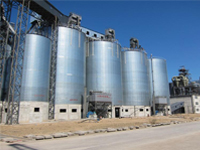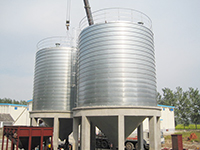I. The introduction of the pneumatic conveying system
The pneumatic conveying system use the energy of the flowing air to transport the particle or powder material in the direction of the air moving.Compared with the mechanical transport,the pneumatic conveying consumes more energy,and the particle is easy to be friable and the device is easy to wear out.The material which is of large water content or adhesion or easily cause static is not suitable for the pneumatic conveying.The main feature of pneumatic conveying is long distance transport and the quantity is large.The velocity is high.
The pneumatic conveying can be divided into dilute phase conveying and dense phase conveying:
1.dilute phase conveying
The solid content is 1-10 kg/m3,the operational velocity is 18-30 m/s,the conveying distance is less than 300 m.
2.dense phase conveying
The content of material in this conveying method is between 10-30 kg/m3 or the ratio of the solid and gas is more than 25.The velocity of the air is low and the air pressure is high.
The conveying distance can reach over 500 m,which is suitable for long distance transport.But the pneumatic and electric device is more than the dense phase conveying and the pressure is high,the pipes is of wear-resistant materials.
Intermittent pressure tank dense - phase pneumatic conveying is to join the particles in the pressure tank in batches, and then blown the material loose, when the pressure in the tank to a certain pressure, the discharge valve will be opened to blow the particles to the transport pipes(Fig.1).

The pneumatic conveying can be divided into to negative pressure conveying and positive pressure conveying.The negative pressure is to suck the material and the air together to the sucking pipes under low pressure.So this type is also named vacuum suction.The positive conveying system transport the material by the air under the pressure which is higher than the barometric pressure.
II. The features of negative pressure pneumatic conveying
1.The negative pneumatic conveying is suitable for conveying material from several points to one point.The feeding inlet number can be one or more. The negative pneumatic can not only send material from several feeding inlet to the discharging place in turn,but also can send at the same time.
2.The material is easily be sucked in under the negative pressure,so the throat pipe feeding is simple.The hopper can be open and the material can be feeding and transporting continually.
3.When the material is conveying under negative pressure ,the water in the material can be easily evaporated.It is more convenient than the negative conveying,the material can be cooled under the heating status.
4.The component need to be sealed,and the separator,dust collector and air lock device is more complex.
5.The fan is placed at the end of the system,which need high level of air purification.
III. The features of positive pressure pneumatic conveying
1.The pneumatic conveyor is suitable for the material to be transport from one point to one or several points.That is the feeding point is one and the discharging point maybe one or several place.
2.Compared with the sucking type,the concentration and transport distance can be greatly increased.
3.The material can be easily discharged from output under positive ,so the separator,dust collector is of simple structure,which usually don’t need the air lock device.
4.The blower or air compressor is placed at the beginning of the system,the device require low air purification.
5.The material under negative pressure is not so easy to flow into the conveying pipes.So the feeding devices structure is more complex.
IV. The feature of the pneumatic device
1.The material is flowing in the closed pipes and it can’t cause environment problems.
2.The energy consumption is low and the noise is also low.
3.The pipes can be flexibly arranged and the footprint is small.
4.The material can be sent for a long distance,which can reach more than 500 meters.
V. The principle of the pneumatic conveying system
Pneumatic conveying is transporting the granular materials alongside the air flowing direction in a closed pipe.It is specific application in fluidization.The device can be easily operated for horizonal and vertical or incline conveying.During the conveying the physical and chemical operations such as heating,cooling,drying and air flow classification can be carried on.
The low pressure air from the air resource flow through the regulating valve(or pressure reducing valve),Butterfly check valve, the activities of duct, nozzle into the diffusion chamber of pump.When the powder or granular material from the hopper down into the the high-speed air flow area between nozzle and the diffuser, that is blown apart. Coupled with the gasification of the bottom of the gasification device, the material is gasificated to suspended. After which the material is sent to the reductive pip in the diffuser by high-speed air, the flow through the throat diffuser pipe into the pipeline.Then it is sent to the required discharging point, that is the whole feeding process.
VI. Application of pneumatic conveying system :
1. Used for cement conveying from silo to silo or from silo to packing machine.
2. Applied on the thermal power plant dust collector fly ash collection conveying.
3. Used for the thermal power plant boiler gas desulfurization system limestone conveying.
4. Other powder material conveying.












 (Live chat)
(Live chat) info@bidragon.com
info@bidragon.com












